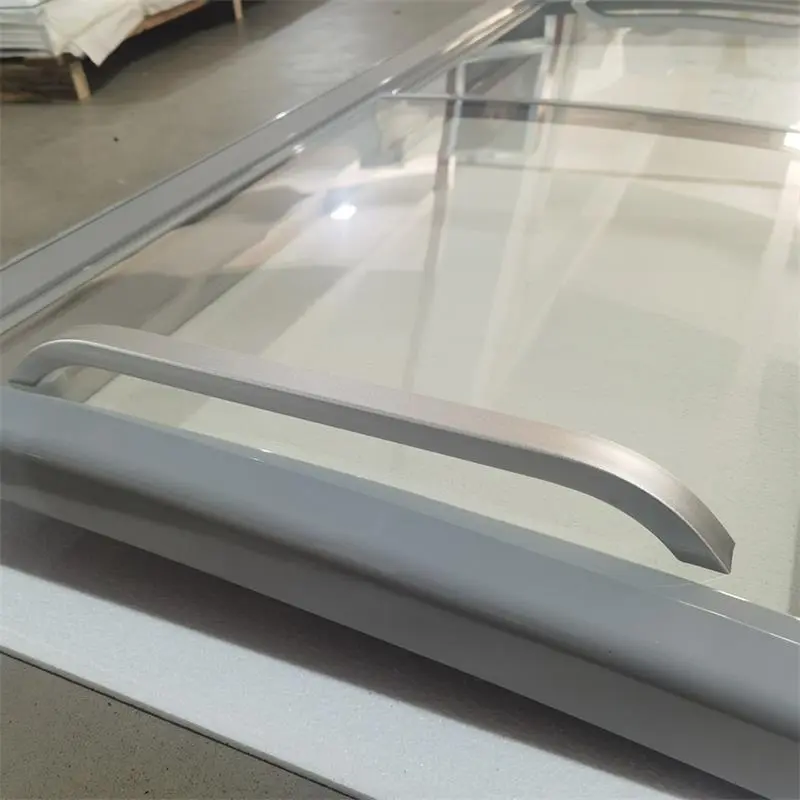Understanding Condensation on Fridge Glass Doors
The Science Behind Condensation
Condensation occurs when humid air comes into contact with a cooler surface, causing water vapor to turn into liquid droplets. This is commonly seen on fridge glass doors, where the cold surface of the glass cools the warmer, moist air surrounding it, reaching the dew point and forming condensation. Understanding this process is crucial for identifying ways to prevent it.
The Effects of Condensation
Condensation not only obstructs visibility but can also lead to other issues such as mold growth, wood rot, and paint peeling. For businesses, particularly those that rely on showcasing products through glass doors, condensation can impede sales by making displays less appealing.
The Role of Temperature and Humidity
Temperature's Impact on Condensation
Maintaining an optimal temperature inside and outside the fridge is essential. A slight increase in the ambient temperature or a decrease in the fridge's internal temperature can help reduce condensation by keeping the surface temperature of the glass closer to room temperature, thereby preventing it from reaching the dew point.
Humidity Control Measures
Humidity plays a significant role in condensation formation. High indoor humidity levels increase the likelihood of condensation. Using a dehumidifier can help control air moisture levels, ensuring the environment is less conducive to condensation.
Identifying Problem Areas on Fridge Units
Inspecting Door Gaskets and Seals
Door gaskets and seals are common areas where warm air can seep into the fridge, exacerbating condensation issues. Regularly inspect these components for wear and tear and replace them as needed to maintain an airtight seal.
Assessing the Fridge's Location
Placing the fridge away from heat sources and ensuring adequate ventilation around it can help manage temperature and humidity levels, thereby reducing the chances of condensation forming on glass doors.
Balancing Indoor Temperature Levels
Adjusting Thermostats
Set indoor thermostats to maintain a consistent temperature that complements the fridge's settings. For optimal performance, the room temperature should ideally be between 20-25°C with humidity levels ranging from 35-50%.
Using Temperature Monitoring Tools
Temperature and humidity sensors can provide real-time data, allowing for swift adjustments to prevent conditions conducive to condensation. These tools can be essential in maintaining an environment that minimizes condensation on glass surfaces.
Importance of Humidity Control in Buildings
Implementing Dehumidification Systems
Installing a dehumidification system can help manage air moisture levels efficiently. This is especially important in climates with high humidity, where excess moisture can lead to frequent condensation on glass doors.
Sealing Leaks and Insulation
Ensuring that your building is well-insulated and that there are no leaks around windows or doors is essential. Proper insulation helps maintain consistent temperature and humidity levels, reducing the likelihood of condensation forming.
Maintenance of Refrigeration Units
Regular Equipment Checks
Regular maintenance of refrigeration units can prevent many issues related to condensation. This includes inspecting cooling systems, checking for leaks, and ensuring that all components are functioning correctly.
Professional Refrigeration Services
Engaging professional services for routine checks can help identify potential issues before they become major problems, ensuring the refrigeration system operates efficiently and reducing the chance for condensation to develop.
Technological Solutions for Condensation Prevention
Anti-Fog and Heated Glass Technologies
Investing in glass doors with anti-fog coatings or built-in heating elements can help prevent condensation. These technologies are designed to either repel moisture or increase the glass temperature slightly to avoid reaching the dew point.
Energy-Efficient Models
Opting for newer, energy-efficient refrigeration models can also minimize condensation. These models often come equipped with better insulation and energy-saving features that help maintain consistent temperatures, reducing the likelihood of condensation.
Temperature and Humidity Monitoring Tools
Installation of Sensors and Controllers
Integrating sensors and controllers in your refrigeration system can provide automated adjustments to maintain optimal conditions. These tools constantly monitor environmental factors and make necessary adjustments to prevent condensation.
Custom Solutions for Specific Needs
Custom solutions, tailored to the specific needs of your environment, can be more effective in managing condensation. Working with suppliers who understand your unique requirements can lead to better outcomes and reduced operational issues.
Benefits of New Refrigeration Technologies
Enhanced Insulation and Efficiency
Modern refrigeration units offer enhanced insulation, reducing the heat transfer between the exterior and interior of the fridge. This not only minimizes condensation but also improves energy efficiency, leading to potential cost savings.
Factory-Installed Anti-Condensation Features
Many new models come with factory-installed features specifically designed to tackle condensation. These include improved door seals and advanced temperature control systems, which help maintain stable conditions within the unit.
Practical Tips for Business Owners
Engage with Reputable Suppliers
Partnering with reputable suppliers can help ensure access to the latest technologies and innovations in refrigeration. Suppliers can offer guidance on the best options for your business needs, ensuring long-term satisfaction and performance.
Implementing Preventive Strategies
Routine maintenance, using the right equipment, and understanding the factors contributing to condensation are key preventive strategies. Educating staff on these measures can also play a critical role in minimizing condensation issues.
Yuebang Provide Solutions
Yuebang offers a range of solutions designed to prevent condensation on fridge glass doors. With our advanced technology, we provide custom, factory-installed anti-fog coatings and heated glass options. Our products are tailored to meet the unique needs of different environments, ensuring effective moisture control. By choosing Yuebang, you benefit from our expertise and commitment to quality, helping you maintain clear visibility and optimal functionality of your refrigeration units. Contact us today for more information on how our solutions can benefit your business.
User hot search: Drinks Fridge Glass Door 2025-09-28 10:01:05
2025-09-28 10:01:05 
